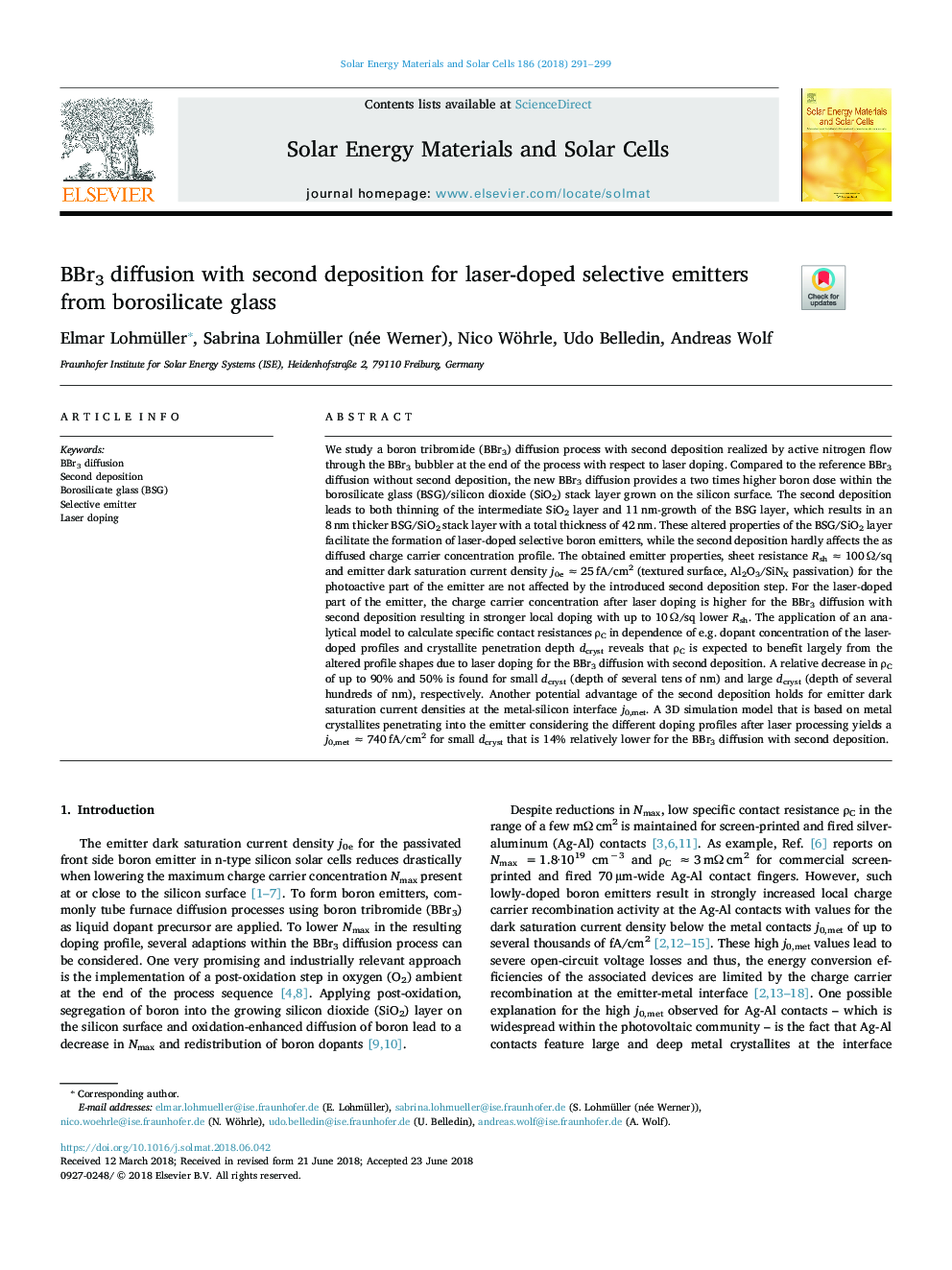| کد مقاله | کد نشریه | سال انتشار | مقاله انگلیسی | نسخه تمام متن |
|---|---|---|---|---|
| 6533886 | 1420637 | 2018 | 9 صفحه PDF | دانلود رایگان |
عنوان انگلیسی مقاله ISI
BBr3 diffusion with second deposition for laser-doped selective emitters from borosilicate glass
دانلود مقاله + سفارش ترجمه
دانلود مقاله ISI انگلیسی
رایگان برای ایرانیان
موضوعات مرتبط
مهندسی و علوم پایه
مهندسی شیمی
کاتالیزور
پیش نمایش صفحه اول مقاله

چکیده انگلیسی
We study a boron tribromide (BBr3) diffusion process with second deposition realized by active nitrogen flow through the BBr3 bubbler at the end of the process with respect to laser doping. Compared to the reference BBr3 diffusion without second deposition, the new BBr3 diffusion provides a two times higher boron dose within the borosilicate glass (BSG)/silicon dioxide (SiO2) stack layer grown on the silicon surface. The second deposition leads to both thinning of the intermediate SiO2 layer and 11â¯nm-growth of the BSG layer, which results in an 8â¯nm thicker BSG/SiO2 stack layer with a total thickness of 42â¯nm. These altered properties of the BSG/SiO2 layer facilitate the formation of laser-doped selective boron emitters, while the second deposition hardly affects the as diffused charge carrier concentration profile. The obtained emitter properties, sheet resistance Rsh ââ¯100â¯Î©/sq and emitter dark saturation current density j0e ââ¯25â¯fA/cm2 (textured surface, Al2O3/SiNX passivation) for the photoactive part of the emitter are not affected by the introduced second deposition step. For the laser-doped part of the emitter, the charge carrier concentration after laser doping is higher for the BBr3 diffusion with second deposition resulting in stronger local doping with up to 10â¯Î©/sq lower Rsh. The application of an analytical model to calculate specific contact resistances ÏC in dependence of e.g. dopant concentration of the laser-doped profiles and crystallite penetration depth dcryst reveals that ÏC is expected to benefit largely from the altered profile shapes due to laser doping for the BBr3 diffusion with second deposition. A relative decrease in ÏC of up to 90% and 50% is found for small dcryst (depth of several tens of nm) and large dcryst (depth of several hundreds of nm), respectively. Another potential advantage of the second deposition holds for emitter dark saturation current densities at the metal-silicon interface j0,met. A 3D simulation model that is based on metal crystallites penetrating into the emitter considering the different doping profiles after laser processing yields a j0,met ââ¯740â¯fA/cm2 for small dcryst that is 14% relatively lower for the BBr3 diffusion with second deposition.
ناشر
Database: Elsevier - ScienceDirect (ساینس دایرکت)
Journal: Solar Energy Materials and Solar Cells - Volume 186, November 2018, Pages 291-299
Journal: Solar Energy Materials and Solar Cells - Volume 186, November 2018, Pages 291-299
نویسندگان
Elmar Lohmüller, Sabrina Lohmüller (née Werner), Nico Wöhrle, Udo Belledin, Andreas Wolf,